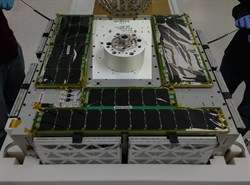AggieSat4 scheduled to deploy from ISS

The AggieSat4 (AGS4) satellite carrying Bevo-2 will be unpacked and assembled aboard the International Space Station (ISS) on Wednesday (Jan. 27), and released into outer space on Friday (Jan. 29). AggieSat4 launched from Cape Canaveral Air Force Station in Florida for the ISS on last month.
Once unpacked, Commander Scott Kelly will attach the satellite to the JEM slide table interfaced with CYCLOPS, a mechanism used to robotically deploy satellites from ISS. The CYCLOPS Experiment Attachment Fixture (EAF) is attached to the large cylindrical CYCLOPS Standoff on the bottom of AGS4. The EAF will be used to lock AGS4 onto the deployment table which will release the satellite from the ISS.
The deployment activities scheduled for Friday include capturing CYCLOPS with the JEM Remote Manipulator System, maneuvering CYCLOPS to the deployment location, and final deployment of AGS4 from CYCLOPS. An example of the deployment mechanism can be seen below.
There are four switches, embedded on the CYCLOPS EAF, that inhibit AGS4 from turning. The first event that will occur after deployment will be the release of these inhibits. Once these inhibits are removed, the Electronic Power System (EPS) starts and initiates a 10 minute timer. After the timer ends the Command and Data Handling System starts and initiates a checkout of every system on AGS4. When complete, AGS4 will begin sending a signal to Earth with its Low Data Rate (LDR) radio, indicating that it is alive and well. The team expects to start receiving signals from AGS4 on Friday evening.
Several days after the release of AGS4, and upon verification that all systems are running correctly, the satellite will power on its torque coils and detumble itself. The torque coils generate a strong magnetic field that will orient AGS4 along the magnetic field of the Earth. There are three torque coils on board giving full 3-Axis motion. The detumble process will negate any rotation imparted on AGS4 by the CYCLOPS deployment mechanism and orient AGS4 for optimal data downlinking. Once this is done data from the satellite can be downloaded faster and all necessary software patches can be uplinked to AGS4.
The AggieSat4 team has been busy preparing for the deployment, setting up the AggieSat ground station at Texas A&M University's Riverside campus. Three antennas have been installed that will be used to communicate with AGS4 while it orbits Earth and collects valuable mission data. One of the LDR antennas has been tested and was able to receive a signal from the same type of handheld radio that is on board the satellite. This antenna will be the main receiver of data transmitted from AGS4 while in orbit. The team is working to ensure the other two antennas transmit and receive properly, and then will raise them to the top of the truss structure they are currently mounted on.
Dr. Helen Reed, professor in the Department of Aerospace Engineering, and the AggieSat team members will be at NASA Johnson Space Center in Houston for the installation and deployment activities. Team members Dexter Becklund and Andrew Tucker will sit on console in Mission Control to assist the astronauts with unpacking, assembly, procedures and any queries. AggieSat team members include Adelin Destain, David Alfano, Dexter Becklund, Ryan Campbell, Jake Cooper, Daniel Ghan, Michelle Gilbert, Hyder Hasan, Andy Holm, Alex Hutson, Mitchel McDonald, Sig Salinas, Robert Singletary and Andrew Tucker.
Provided by Texas A&M University




















